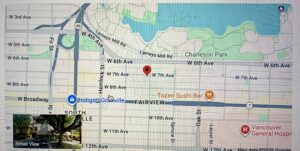Fairview, Vancouver
November 19, 2025 By: Chelsea Brown
Location: 1202 West 7th ave Vancouver BC

For Exercise #1: Local Environmental History
I currently reside in Fairview, a lovely area of Vancouver, where I have lived with my partner for over two years. Thuncher (2014) explains that the name Fairview came from its scenic views, and that “fair” still meant the same thing as “beautiful” when it was first named in 1886. I agree with this statement, as you get fantastic views of the city and distant mountains. One of the aspects I appreciate most about living in Fairview is its central location – we’re close to downtown, yet removed from the hustle and bustle. Additionally, the proximity to the seawall and waterfront is a definite plus. Although the neighbourhood is near busy streets, it feels like a peaceful suburban area just a few blocks away.
The Vancouver Heritage Foundation explains that, for thousands of years, Indigenous peoples were the primary inhabitants of the area now known as Fairview. This neighbourhood is located on the unceded traditional lands of the xʷməθkʷəy̓əm (Musqueam), Sḵwx̱wú7mesh (Squamish), and səlilwətaɬ (Tsleil-Waututh) nations, which are all a part of a larger group called the Coast Salish people. Before colonization and settlement, Fairview was a densely forested region dominated by “large fir trees, shared among two of the three Nations (Vancouver Heritage Foundation)”. The Coast Salish peoples in the Vancouver and Fairview area include the Tsleil-Waututh and Musqueam. According to the City of Vancouver Heritage Foundation (n.d.), the Tsleil-Waututh, known as the “People of the Inlet,” have a deep connection to Burrard Inlet and its resources. The Musqueam have lived in the area for over 4,000 years and are recognized for their strong ties to the land, their fishing practices, and their resource management (City of Vancouver Heritage Foundation, n.d.).
Before settlement, the Fairview area was heavily forested and home to many different types of wildlife, including birds, small mammals, and fish. However, as the City of Vancouver. (n.d.). Fairview: Neighbourhood history and heritage state that settlement began in the 1870s, with logging of the forest starting in the same year, and that Fairview was officially established and named in 1886. A fun fact that I have always been curious about in Fairview is that many of the cross streets are named after trees, such as Alder, Birch, and Arbutus. Thuncher (2014) explains that CPR Land Commissioner L.A. Hamilton named Fairview to organize the area.
Due to extensive logging and urbanization, the habitats of local wildlife have been altered. The City of Vancouver (n.d.) explains that the Canadian Pacific Railway (CPR) played a key role in clearing the land, leading to the development of shipbuilding yards, sawmills, shingle mills, and various woodworking plants, which soon replaced the forest. The rapid growth and development of housing made Fairview one of the first “industrial suburbs in Vancouver (City of Vancouver Fairview Neighbourhood history and heritage).” Additionally, when the Cambie Bridge was built in 1891 and the Granville Bridge and street in 1889, it made it easier for people to travel to and from downtown Vancouver (Heritage Foundation, n.d.).” Many houses were built during this period to provide accommodation for workers at nearby sawmills. Two heritage houses remain on my street that were built in the 1890s and early 1900s. The house nearest to my home is called “Hondson Manor,” and according to Heritage Site Finder, it was the residence of Captain James Login in 1894. It was later owned by businessman William Hodson until 1940. In 1974, the building was moved and restored as a community centre. Now owned by the “City of Vancouver,” it hosts the Vancouver Chamber Choir, Vancouver Cantata Singers, and Early Music Vancouver (Heritage Site Finder).
Like many urban areas, Fairview faces challenges from invasive species. According to the Invasive Species Council of Metro Vancouver, “non-native plants such as English ivy, Himalayan blackberry, and Japanese knotweed have spread extensively”, outcompeting native plants and disrupting local ecosystems. Additionally, managing and restoring habitats has become crucial to the City of Vancouver’s ongoing environmental stewardship. Often, Vancouver is referred to as a Green City due to its 2011 Greenest City 2020 Action Plan, which aimed for “Vancouver having the cleanest water in the world (Vancouver’s Rainwater Management Plan, 2016).” Although there is no evidence that Vancouver reached this goal, the regulated, well-tested plan helps ensure clean water is available to residents. I tried to find more history and knowledge specifically for the Fairview area, but could not find anything. However, Fairview and many other neighbourhoods in Vancouver have adopted a range of stewardship measures similar to those in many different parts of the city. According to the City of Vancouver’s Rainwater Management Plan (2016), stormwater management systems, including rain gardens and green roofs, help control water runoff.
References
City of Vancouver. (n.d.). Fairview: Neighbourhood history and heritage. Retrieved November 18, 2025, from https://vancouver.ca/news-calendar/fairview.aspx
City of Vancouver Heritage Foundation. (n.d.). Indigenous heritage. Vancouver Heritage Foundation. Retrieved November 18, 2025, from https://www.vancouverheritagefoundation.org/discover-heritage/indigenous-heritage/#:~:text=%CF%87%CA%B7ay%CC%93%CF%87%CA%B7%C9%99y%20%CC%93%20(Lumberman’s s%20Arch%2C%20Stanley,for%20by%20a%20community%20group
CityStudio Vancouver. (2018). History Boards: City of Vancouver. https://www.citystudiovancouver.com/wp-content/uploads/2018/04/HistoryBoards2.pdf
City of Vancouver. (2016, March 30). Rainwater management plan and green infrastructure strategy (Report to the Standing Committee on City Finance & Services, April 20, 2016). https://council.vancouver.ca/20160420/documents/cfsc7.pdf
Green City Times. (n.d.). Vancouver. Green City Times. https://www.greencitytimes.com/vancouver/
Heritage Site Finder. (n.d.). 1254 W 7th Ave, Vancouver, BC. Retrieved November 18, 2025, from https://www.heritagesitefinder.ca/location/1254-w-7th-ave-vancouver-bc/
Invasive Species Council of Metro Vancouver (ISCMV). (n.d.). Invasive plants. Retrieved November 18, 2025, from https://iscmv.ca/invasive-species/invasive-plants
Thuncher, J. (2014, February 13). Fairview: The neighbourhood at a glance. Vancouver Is Awesome. https://www.vancouverisawesome.com/courier-archive/community/fairview-the-neighbourhood-at-a-glance-2968631
Vancouver Heritage Foundation. (n.d.). Takehara / Yada Apartments (Japanese Nagaya tenement house). Places That Matter. Retrieved Nov 18, 20,25 from https://placesthatmatter.ca/location/japanese-nagaya-tenement-house/